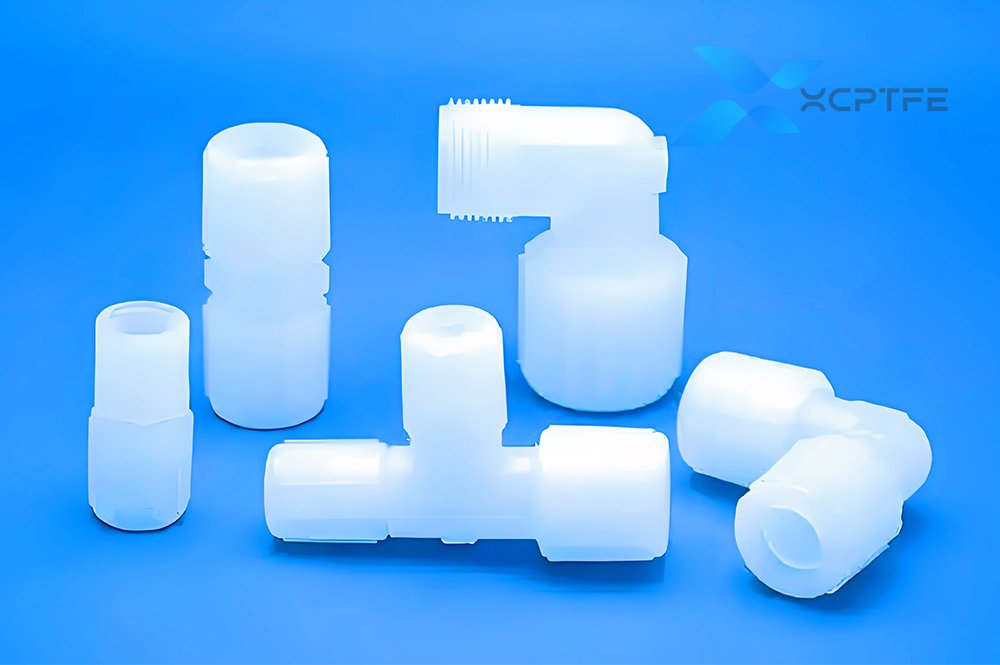What is the difference between PTFE PFA FEP ETFE?
1. PTFE (Polytetrafluoroethylene)
The most famous product name: Teflon ®)
Core feature: “Plastic King”, possessing the highest chemical corrosion resistance and widest working temperature range among all fluoroplastics. Its friction coefficient is extremely low, and the surface is extremely non sticky.
The biggest disadvantage is that it cannot be processed through conventional melt injection molding or extrusion processes. Because it is extremely viscous even at high temperatures and does not become a flowable melt. Usually, parts need to be manufactured through a process of compression molding (cold pressing)+sintering, or powder dispersion is used for coating. Plates and bars can also be machined into seals through turning.
Main applications: high-performance seals (such as O-rings, gaskets), bearings, piston rings, lining of chemical equipment (pipes, valves, kettles), laboratory vessels, non stick pan coatings (early).
2. PFA (Perfluoroalkoxy Alkane)
Core feature: It can be regarded as the “melt processability” version of PTFE. It almost retains all the excellent properties of PTFE (extremely high chemical resistance, non adhesiveness, high and low temperature performance), but at the same time can be processed through injection molding, extrusion, blow molding, and other methods like ordinary plastics. It also has good transparency.
Disadvantage: The price is the most expensive among the four.
Main applications: fields that require extremely high purity and performance, such as etching machine components in semiconductor manufacturing equipment, wafer carriers, high-purity chemical transport pipelines, and storage tanks. It is also used for highly demanding non stick coatings and advanced wire insulation.
3. FEP (Fluorinated Ethylene Propylene)
Core feature: Developed to improve the processability of PTFE. It can be melt processed (injection molded, extruded) like PFA, and has extremely high transparency and better flame retardancy.
Difference from PFA: Its long-term use temperature upper limit (about 205 ° C) is lower than PTFE and PFA (260 ° C). The mechanical strength and stress cracking resistance at high temperatures are not as good as PFA.
Main applications: insulation layer for wires and cables (especially in the fields of data communication and aerospace), transparent mirror and pipeline lining for corrosive chemicals, and backsheet film for solar panels. It has also been used for non stick coatings.
4. ETFE (Ethylene Tetrafluoroethylene Copolymer)
Core feature: It is a copolymer of ethylene and tetrafluoroethylene, therefore its mechanical properties are very outstanding: extremely high impact strength, wear resistance, and tear resistance. It has both good chemical resistance and transparency.
The difference from the first three is that it has a lower fluorine content, so its temperature resistance and chemical inertness are not as good as PTFE/PFA/FEP. But it has a unique advantage: excellent radiation resistance (especially ultraviolet).
Famous application: The inflatable membrane on the exterior of the “Water Cube” at the Beijing National Aquatics Center is made of ETFE membrane material. It is also widely used for wire and cable sheaths in the aerospace industry, cable insulation in nuclear power plants, anti-corrosion lining and coating of chemical equipment.
Summary and selection suggestions
Requires the highest temperature resistance and chemical inertness, with a simple or machinable shape ->choose PTFE.
Need to approach the performance of PTFE, but the complex shape of the product requires melting processing (such as complex pipelines and valves), and the budget is sufficient ->choose PFA.
Good transparency and melt processability are required, but the working temperature should not exceed 200 ° C ->FEP should be selected.
Requires extremely high mechanical strength, impact and tear resistance, good weather resistance and transparency, with slightly lower temperature resistance requirements (<150 ° C) ->Choose ETFE.

